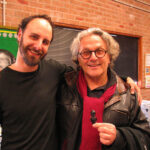Want your guitar to shine like new? Achieving a stunning, glossy finish on your guitar is easier than you might think with the right approach and, crucially, the correct Guitar Polish. This guide will walk you through the essential steps to make your guitar’s finish truly pop, enhancing its beauty and protecting its integrity.
Step 1: The Crucial Clean
Before you even think about polish, cleanliness is paramount. Start by gently wiping down your guitar with a damp, high-quality microfiber cloth. The type of cloth is critical – avoid anything abrasive like polyester, which can actually scratch your finish, even when you’re trying to clean it! Microfiber, flannel, or cotton are your best bets for a scratch-free clean. This removes surface dust and grime, preparing the finish for deeper treatment.
Step 2: Rubbing Compound for Deeper Scratches
If your guitar’s finish is looking dull or has noticeable surface scratches that haven’t penetrated the paint, a rubbing compound can be your friend. However, use it cautiously! For guitars with thick finishes like older Fenders, you might use a medium compound for more significant issues. But for thinner nitrocellulose finishes, common on Gibsons and some Fender models, proceed with extreme caution or opt for a very fine compound to avoid damaging the finish. Rubbing compound is essentially a mild abrasive paste that levels out minor imperfections by removing a very thin layer of the clear coat. Always use a clean cloth to apply and buff.
Step 3: The Magic of Guitar Polish
Now for the guitar polish itself. While some products market themselves as “polishes” but are actually detailing fluids, true guitar polish is a very fine abrasive. It’s designed to smooth out the finish even further after using a compound, or as a standalone step for finishes in good condition. For optimal results, consider using a couple of grades of guitar polish, starting with a slightly more abrasive one and moving to finer grades to achieve an increasingly smooth and reflective surface. Car polishes like Meguiar’s #7 and #9 are popular choices and readily available. Apply a small amount in gentle circular motions with a clean cloth, frequently turning the cloth to ensure you’re always using a clean surface.
Step 4: Glaze for Ultimate Shine and Flaw Concealment
At this stage, your guitar finish should already be looking significantly shinier. Glaze steps in to fill in microscopic imperfections that are barely visible, enhancing the overall gloss. It also boosts the shine even further. Mother’s Show Car Glaze is a well-regarded option. Apply a thin, even layer with a clean cloth, let it haze over, and then buff to a brilliant shine.
Step 5: Wax for Protection and Enhanced Depth
Wax adds another layer of shine and, crucially, protects your guitar’s finish from UV rays, minor abrasions from clothing, and environmental pollutants. Apply wax similarly to glaze, in a thin, even layer. High-quality waxes, like those from Music Nomad, can be layered for an even more impressive “3D” shine and increased protection.
Step 6: Detailing Fluid for Maintenance and Shine Prolongation
Detailing fluid, sometimes mistaken for guitar polish, is used for regular maintenance. Products like Dunlop 65 are detailing fluids. They clean off everyday grime, add a protective layer over the wax, repel liquids, prolong wax life, and boost the overall shine. Use it regularly to keep your guitar looking its best between deeper polishing sessions.
Achieving a show-stopping, mirror-like finish on your guitar requires time and attention to detail, but the results are well worth the effort. By following these steps, from careful cleaning to the final detailing fluid application, you can significantly enhance your guitar’s appearance, protect its finish, and make it truly shine. Remember to always use quality products and clean cloths for the best possible outcome.

